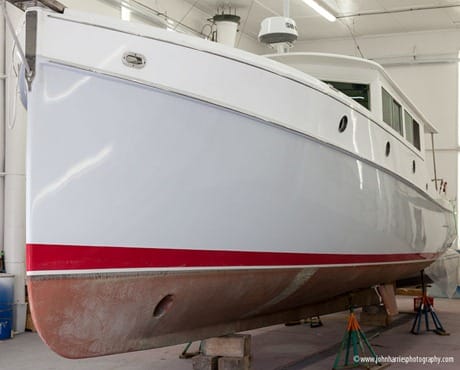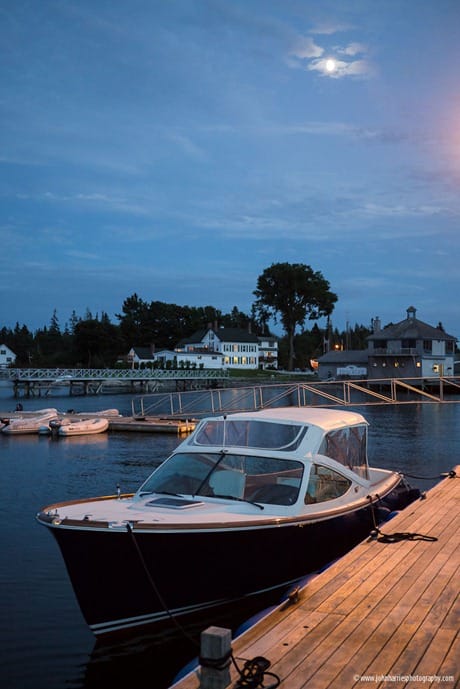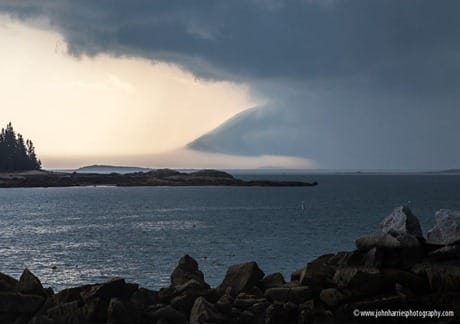A great piece by Charley Doane over at Wavetrain on the folly of carrying jerry jugs of fuel on deck and how to make it unnecessary with smart motor-sailing.
More Long Thin Boats

Click on photographs to enlarge.
I can’t get enough of these long thin boats. I came across this one in the paint shed at Billings Diesel and Marine. Tad Roberts, who designed her, has a very interesting web site.
And here is Matt Marsh’s—who provides great engineering and all around common sense in our comments here at AAC—take on a long thin power boat—looks like great minds think alike to me.
A rough guess would say that both boats can cruise at 7 knots on a little more than half a US gallon an hour. Say 11 to 12 nautical miles per gallon! Or, for our European readers, about 3 nautical miles per liter. Boats for the future, I say.
LOL

This is a Hinckley Picnic Boat. I was chatting with a friend on the Hinckley dock at Southwest Harbour, Maine, where we had both cleared customs coming in from Nova Scotia. He gestured at the boat in the picture and said “you know what I call those?…Mooring Bling.” I nearly fell off the dock.
Time to Reef!

The leading edge of a thunderstorm, Stonington Maine. When you see a cloud like this, as they say in the Caribbean, “If you ain’t scared, you ain’t right” (in the head).

John, here’s another powerboat for you: the Fayerweather, from Osterville on Cape Cod. http://www.edmondsdesign.com/drawing.html
With 60 LOA and an 11 1/2 ft beam, it’s actually beautiful to watch as it slices through the chop on Nantucket Sound – beautiful for a powerboat, anyway.
Hi Colin,
Thanks for the link. As you say, a very cool and beautiful looking boat, although I’m not really interested personally in boats of that speed and power. I wonder if when trying to go that fast economically, a power cat does not make more sense, as Richard (RDE) has said.
John,
Thanks for posting the nice picture of Memory. She’s 10 years old now and currently listed for sale.
It seems folks have long been saying the time has come for long skinny boats…..so far I don’t see it. My Passagemaker Lite series have been out there for 10 years as well, yet to be noticed by boatbuilders. The reality is that few powerboats are under way enough to warrant any concessions to fuel efficiency. A while back I did some research of the current 15 Nordhavn listings of 50′ or less, not including the 35′ coastal cruiser. They range in age from 3 to 20 years, and engine hours (time under way) ranges from 83 to 530 hours per year, but these are extremes. The average for 15 boats is 284 hours (11.83 days) under way per year.
Thus it follows that moorage cost (by the foot of length) is a far larger concern than fuel cost.
Hi Tad,
I have spent several happy hours looking at your Passagemaker Lite series and so hearing your news that no builder has shown interest is disappointing.
Having said that, I do wonder if we might be nearing a tipping point toward long thin offshore motorboats and away from trawler yachts. I feel a post brewing…
When one well established company (Nordhavn) owns a market sector (offshore motorboats), it is impossible to compete without enormous capitalization. Dashew has invested millions and years in competing for perhaps 2% of the market….
In the 37 years since Bob Beebe first published Voyaging Under Power, ocean cruising in powerboats has never really taken off……perhaps it’s the lack of the romance (and perceived freedom) of cruising under sail. But my general feeling is that it’s a lack of reasonably (low) priced vessels that can do the job. You can buy a Cal 29 for 10k, outfit for another 10k, and head off to the South Seas. There are no (that I know of) ocean crossing motorboats available at these prices.
Working as a yacht construction manager in BC and Washington state (the “expedition” yacht capital of the world) I tried to interest several large builders in the idea of developing a fiberglass 75′ design incorporating the efficiency concepts developed and proven by Steve Dashew — perhaps with a bit more attractive styling.
I was soon brought back to reality by their knowledge of their market. “Owners with enough money to buy a 75′ yacht have no time or interest in crossing oceans themselves, and a narrow boat is too small for professional crew” “Long distance performance is unimportant— interior volume is what sells. ‘ “Buyers like the rugged image of a trawler— they won’t buy a 75 footer with the interior of a 55 footer.” “Truth be told, yachts are purchased to project an image, not to use.” “Our buyers want a yacht bigger than those of their peers, not more unusual”
Fact of the matter is, Steve Dashew does a better job of designing and selling his type of yacht than any of the firms I spoke to could ever do, and the real market for an optimal long range motor yacht is so small he probably accounts for half of its potential buyers.
Hi Richard,
All good points, as usual.
To me, the key issue here is that it is very difficult, or even impossible, for a builder or designer to sell an innovative and better alternative, like long thin powerboats, or, for that matter, a simple, strong, reasonably priced sailboat, because they don’t have the audience size and further because the audience perceives builders and designers as selling their product and therefore discounts what they say, no matter how sensible.
But, as Steve has proved, things can be changed by someone with a large internet audience and the credibility conferred by a lot of offshore miles.
I also think that the market for a less expensive long thin offshore power boat may be larger than that attracted to Steve’s boats at 2.5 million each.
Hum…
Tad – The PML series may not be selling too well, but that’ll change. They are absolutely gorgeous designs that ought to appeal to the style-conscious professional crowd as well as to long-range cruisers. Nobody notices “melting jelly bean” styling anymore, but a PML would surely turn heads in any marina full of white plastic. That counts for a lot when successful professionals are the likely buyers.
John – I tend to agree that the market for Dashew boats is limited more by their cost than by the demand for their capabilities. One FPB 64 is worth as much as seven really, really nice houses in my city. It costs more than most couples will make in their entire working life. They’re amazing boats, but they are only for the very wealthy. If the key concepts of the design were available at a realistic price, I think there would be a viable (albeit not huge) market for that.
Matt,
Thanks for your kind comments, it’s nice that someone noticed. As I mentioned above capitalization is at least part of gaining market share. The uncertainties of a new custom build are huge in comparison to the purchase of an existing stock boat, such as a Nordhavn, of which there are plenty available in a buyers market. One of the realities I see is that folks buy a voyaging motorboat for a specific trip, then move on to the next adventure and put the boat on the market. Again the known entity (stock boat) will sell more readily….until the alternative (our long skinny boats) becomes fashionable and desirable…….:)
On the opening picture, the guy filling all those jerry cans with fuel, to cover the deck of this sailboat..
What do you guys REALLY think of this photo?
Here’s what I see. I see a poor insecure soul. Unable to have confidence in sailing this sailboat of his. He has a far stronger belief/faith in powering through, even upwind in stiff winds & a heavy chop. Or even downwind for that matter.
Basically I see someone who has no business sailing. Who would be much happier on a powerboat. Or ashore.
I see someone confused. I see someone who hopefully in a few years will figure it out & sell the boat & move to something more suitable for his needs.
All that clutter on deck to satisfy his insecurity, incredible….
Hi Nick,
Probably a good analysis and done with your usual diffidence :-).
When a few of those diesel jugs come adrift and spill onto the deck he will be REALLY insecure—.
John, All those jerry cans need to be secured on deck also. It is my take, that those who secure things like jerry cans, kayaks, fender boards, passerelles etc to life lines and stanchions have never fallen off a wave mid-ocean. It is a recipe to lose your life line/stanchion assembly. That said, I hope his intention is to go down the ICW (Inter Coastal Waterway- lots of motoring down the east coast of US in protected waters where sailing is unlikely) non-stop. Dick Stevenson, s/v Alchemy, Yarmouth, England
Hi Dick,
I could not agree more, as I ranted about in this post. In fact, I would argue that it is even worse than just losing the life lines and stanchions, since there is a good chance that the stanchion bases could be ripped out of the deck leaving large boat-sinking holes behind them.
The sad thing is that Charlie took that photo in Bermuda.
Dear John,
I think you mentioned once that you were a length junky; when in doubt go longer. I think I will occasionally make the case for more modest size vessels. Our dream boat (15+ yrs ago) was a Sundeer type, longer and skinnier. Even the first few years of live-aboard where we anchored out 2-300 nights a year and length was not an issue, I very seldom wanted a bigger boat than our 40 foot hull. Since our plans brought us to the Med for 5 years and to the UK for the last year I have been very thankful to have a 40 foot boat. It makes so many things so much easier. Now that we have been cruising the French Atlantic coast and the UK/Ireland areas we find it very refreshing to be in places where there are numerous enthusiastic knowledgeable sailors, far more than any area yet cruised, and many are in sea-smart 35-40 foot boats. There are many areas where bigger boats have room and are welcomed, but there is a lot that is closed off or with limited offerings (and always more expensive) to boats larger than 40-45 feet.
I would suggest that much of the appeal of longer boats, even longer skinnier boats, has to do with what I call luxury items, being able to do longer runs between harbors in daylight, carry bicycles, entertain and have guests, etc. I would dispute the sometimes subtly promoted suggestion I sometimes perceive that longer is safer or more seaworthy. Occasionally there are safety issues, but most of us, even the longer boats, are not going to outrun storms at sea by going 200 mile days. And generally smaller is better when cascading problems occur. Also for most of us, our interest in efficient motoring is not clearly a monetary issue if we are spending upwards of a dollar a mile on sails and its ancillary gear. I would finally suggest that the larger you go (in general), the more sea-smarts/experience you need to have under your belt to stay out of trouble.
That said, I certainly suffer from “length envy” as I read some of the reports. And I certainly admire those pioneers who develop the designs being discussed and lament their lack of appreciation (and remuneration). I think the wisdom of well designed long & skinny for seaworthiness, efficiency etc is little disputed. And I also appreciate the dissemination of what makes for a seaworthy vessel, power or sail. Most people have far too few examples of wise boats nowadays with magazines, brokers, etc operating as little more than advertising media for boats wedded to high interior volume and/or low production cost.
Most assume that one buys the boat length they can afford and as a broad assumption, that seems to have validity, especially in talking about cruising level boats. It is possible to choose a smaller vessel, even if bigger is in the budget and for many that would be good judgement. I would finally suggest that, when in doubt, go smaller and you are likely to be pleased with your choice most of the time.
My best to all,
Dick Stevenson, s/v Alchemy, Yarmouth, England
Hi Dick,
Great comment full of a lot of wisdom, thank you.
As you say, I’m a self confessed length junkie. But not length alone. Length for a given displacement. The key point being that I think it is vital when discussing this issue that we define size in terms of displacement, not length.
For example, “Morgan’s Cloud” is 56 feet overall, but only weighs in at ~50,000 lb with a full load of fuel water and food for six months. That is a a full 15,000 lb lighter than many boats of about the same length, like, for example, the Little Harbour 53.
Also, the Adventure 40 will weigh in at 18,000-20,000, half load, again much less than many cruising boats that are 40-feet long.
The point being that I believe that for a given length it is better and more sea-worthy to have a longer, thinner, boat, than the floating condos you see today.
So, your Valiant 40, is, to me, just as a desirable boat as “Morgan’s Cloud”—just smaller and tasked for a different purpose.
One thing I would differ with you on is the issue of the safety conferred by a bigger (displacement) boat. The key thing to remember here is that the force required to capsize a boat goes up by the cube of size. This is huge and the reason that larger boats are knocked down very rarely. (If memory serves, in the tragic 1979 Fastnet Race, no boat over 40-feet was inverted, or lost.)
Of course, safety has many parts, and, as you say, the relative ease of handling the gear on smaller boats has great value too.
Hi Dick,
And then there is always the extreme case that adds an exclamation mark to the debate. A number of years ago I was in Cruz Bay, St. John. Paul Allen’s yacht is so big they had to anchor so far offshore you could hardly see the damn thing, and tragically there was no place to land the helicopter ashore near the best fish restaurant on the island.